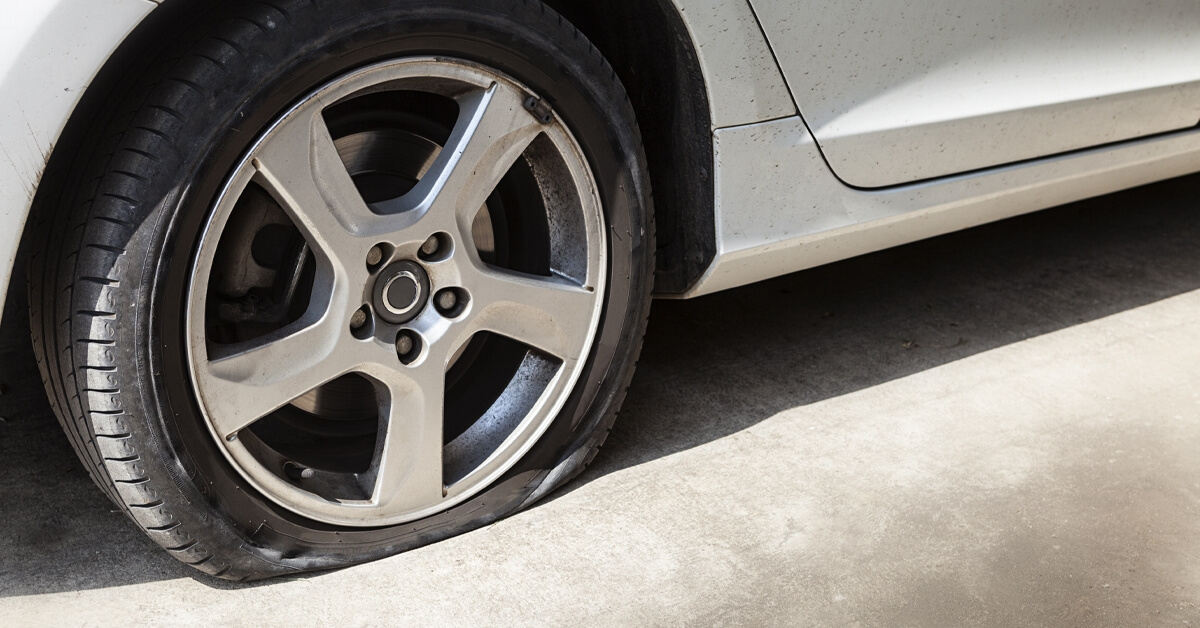Can You Drive With A Flat Or Punctured Tyre?
Everything you need to know about tyre puncture.

Find your tyre
READ THE DIMENSIONS OF TYRES

With the continuous improvement in tyre technology, punctures and blowouts are becoming a rare occurrence. Still, when they do happen it's best that you know what to do. So, how do you handle a tyre puncture? Can you drive with a flat tyre? Or how to repair a punctured tyre? Here’s everything you need to know about a flat or a punctured tyre.
How do you know if the car tyre is punctured?
After the tyre gets punctured it might not go completely flat immediately. These are some of the signs that can be noticed while driving that indicate your car tyre has been punctured.
- The steering becomes hard and difficult.
- While driving the car you might feel unwanted vibrations and unstability.
- The car pulling towards the right or left depending on the side where the tyre is punctured.
- The unusual squealing of the tyres.
Can you drive with a flat tyre?
Driving with a flat or a punctured tyre is never recommended. An optimally inflated tyre provides cushioning to the wheels and absorbs shocks from the road. When a tyre is punctured, it loses air and its ability to absorb shocks, eventually becoming completely flat if left unchecked. If you continue driving on a flat tyre you are now driving on the rim and not on the tyre. As a result, the rim is in danger of severe damage. Furthermore, continuing to drive on a flat tyre may damage not only the rim but also the vehicle's suspension, brakes, steering, alignment, and other components.
So, what can you do instead?
Here are a few alternatives on what to do when you have a flat or a punctured tyre.
It is never recommended to drive on a punctured tyre. However, if you are driving in the middle of a highway and suffer a tyre puncture you may want to pull to the side of the road or drive to the nearest tyre shop. To do so, slow down as soon as you discover indicators of a puncture, switch on the hazards light, and carefully pull over to the side of the road. Perform a quick visual inspection of the tyre to gauge the severity of the damage. Having a spare tyre comes in handy in such situations. Alternately, having a tyre patch kit or a temporary tyre repair kit ready could also help if the puncture is not too severe. In any event, once you've completed the interim fix, make sure to see the nearest tyre repair shop for additional diagnosis and support.
And, in case you do not have a spare tyre or a temporary tyre repair kit you could call for roadside assistance. Fortunately, in UAE there is a network of trusted TYREPLUS mobile fitting services that can assist you in an emergency and provide tyre repair and replacement services at your location.
How far can you drive with a flat tyre?
When you have a flat tyre, it is usually best to avoid driving any further and stop immediately. However, if you have runflat tyres like the Michelin ZP tyres you get the benefit of driving upto 80 kms at a reduced speed of 80 kms/hr.
Should you repair or replace a punctured tyre?
The car tyres can endure a certain degree of damage. The severity of the damage and tyre puncture location are the major determinants to know whether the puncture can be repaired or needs replacement.
Tyre puncture repair is possible if:
- Puncture through small objects: Slow puncture in car tyres is caused due to piercing of tiny sharp objects such as nails, screws, glass pieces, etc. They usually cause small holes or cuts in the tyres causing air to escape gradually. Though it cannot be considered as severe damage it should be fixed or repaired immediately. Slow punctures can lead to blowouts while driving at high speed.
- Puncture is less than 5mm in diameter: If the tyre cut or puncture is less than 5mm in diameter then the tyre can be easily repaired through proper repair method which ensures the safer operation of tyre.
- Puncture is within repairable area: The location where the tyre is punctured is a major factor determining whether it can be repaired or not. If the damage is on the tread area within repairable limits, then the puncture can be repaired. Damage to the tyre sidewall cannot be repaired.
Tyre puncture repair is not possible if:
- Puncture is deep and big: If the tyre hole or cut is bigger than 5mm in diameter then the deflation is quick and there are high chances of severe damage to the tyre.
- Weakening of the internal structure: Rough cuts and deep holes compromise the internal tyre structure by weakening it. Visibility of the tyre bead, internal casing damage, and other such damages cannot be repaired. It puts the tyre’s functioning and the safety of the car at risk.
- Tyre sidewall puncture: The flexible sidewall structure cannot be patched or plugged. Tyre sidewall being a vital part of the tyre structure has the utmost contribution towards tyre’s performance. Thus, repairing the damage to this integral part is not recommended.
How to repair a tyre puncture?
While several repair procedures are used, Michelin, the leading tyre manufacturer, suggests mushroom repair for fixing a puncture on a passenger car tyre. At a tyre puncture repair shop in general, the initial step for tyre repair is demounting of the car tyre. Then, a thorough inspection of the car tyre is done to determine the exact location of the puncture. After finding the puncture, the punctures area of the tyre is sealed by using a mushroom patch.
Tyre punctures cannot be predicted; a small nail or a piece of glass on the road that cuts through the tyre can cause a puncture. The best way to avoid unpleasant consequences when driving is to take a minute and inspect your tyres before hitting the road. Look out for warning signs such as the presence of foreign objects like a nail, ageing or other damages. Your tyres might look perfect to you from the outside but, they could be suffering from severe damage. It’s recommended to always get those tyres checked by a tyre expert to be safe on the road. With proper tyre maintenance, you can avoid sudden tyre bursts. Monitoring the tyre pressure, rotating the tyres periodically to avoid uneven wearing, checking for leakages, measuring the tread depth, inspecting the wear and tear, routine wheel alignment and wheel balancing are essential tyre services that have to be a part of your routine tyres and car maintenance.
